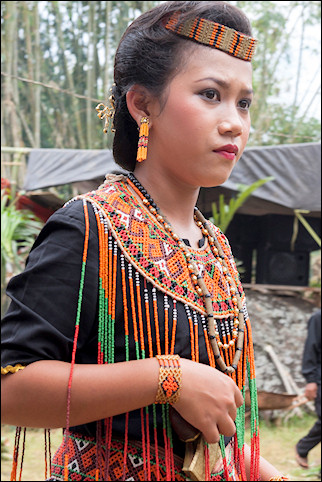
|
Bicycle Vacation
South Sulawesi
Tradition and hospitality amidst many shades of green
Amidst green mountains with rainforests and paddies old traditions still live on Sulawesi (formerly Celebes). Ships are still hand built in Tanaberu. Bricks are also still made by hand. Fishers villages float on Lake Tempe. And then there are Buginese pile dwellings and a mourning ceremony in Rantepao that lasts for days. Bicycling means waving at people, say 'hello' and be stared at. And having our pictures taken with everyone we meet.
Travelogue & photos: Aart & Gerrie Dijkzeul
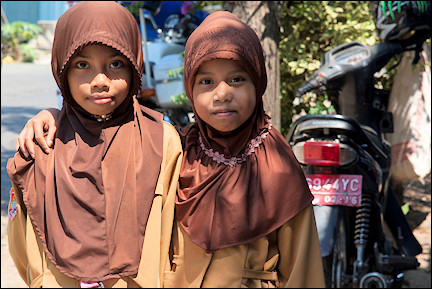
|
After over thirty hours, two books and 15,000 kilometers we arrive at our destination: Makassar in South Sulawesi.
After a day of lazying about in the city we get on our bikes. The first three days of our trip we will follow the southern coastline, bicycling east to Bira.
Along the south coast to Bira
Fishing boats are still built by hand in Tanaberu
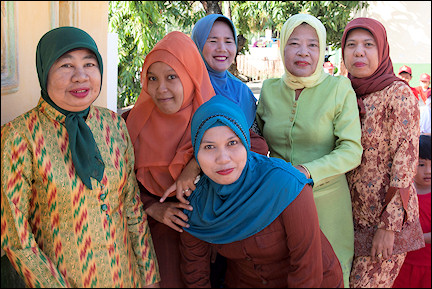
|
We get up early for our first day of bicycling; we leave at 6:30 AM. It could get hot today. The ride isn't easy: a strong headwind and - already this early - very hot. The Indonesians make up for our discomfort by their friendliness and enthusiastic waving.
Teenagers with mobile phones want their pictures taken with us, older people ask if we can take their pictures. And thus many photos end up in the digital trash every night.
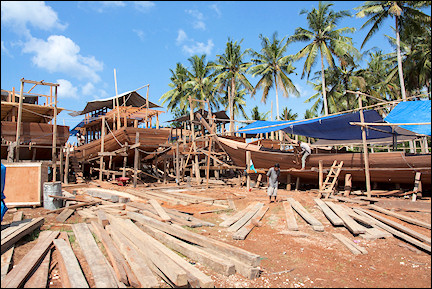
|
In Tanaberu our eyes feast on the shipyard where fishing boats are still built by hand. It is a spectacular sight: thick planks and wooden pins are put together to form a thirty meters long ship. No drawings; there is just the design that has evolved over the ages.
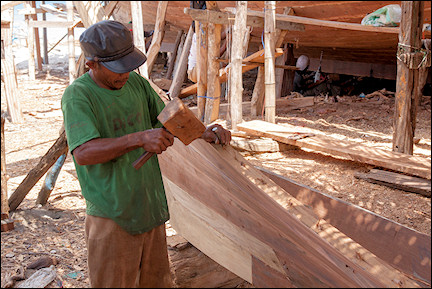
|
Bira lies on the southeast corner of Sulawesi. The sea is clear blue, the sand white and the beer cold. What more can you want? Beer is not at all something that goes without saying in this predominantly Islamic country.
Northward to Sengkang
Visiting floating villages by boat on Lake Tempe
After two days of relaxing we continue on our trip. We will ride to Sengkang in three days. The bridge in our route description is gone; a new one is being built. We can either make a detour of dozens of kilometers or use the ferry, which looks like a plus-size canoe. We choose the latter.
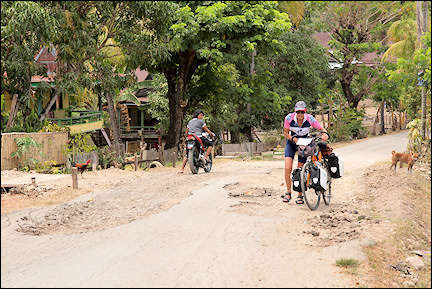
|
The negotiations about the fare and - at least as important - loading and unloading the bikes - are terribly confusing. Money changes hands quickly. But we have completely forgotten this by the time we are on the other side, safe and sound.
What follows is a cobble path, comparable with the grit beach at Normandy. In one word: exhausting. We take a break at a covered bus stop where Gerrie wants to take a nap. It is a kind of bamboo shed, with seats and a place to lie down.
As soon as Gerrie closes her eyes, the whole village comes to visit: elderly people, youngsters, babies... Mobile phones click. Every now and then someone who is waiting for a bus joins us. It's a lively gathering. Meanwhile, Gerrie rests as if nobody is there.
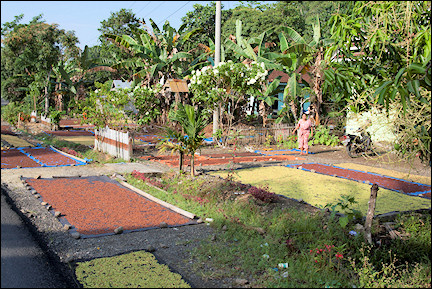
|
In Singai we visit Fort Balangnipa, from 1868 the seat of government of the Dutch in Indonesia. It's weird to walk there, as offspring of the colonialists.
The surroundings of our bike route are green and varying. Lots of villages and ribbon building, wilderness and along the coast mainly paddies. Inland also tobacco, cocoa and coconuts. Along the road, colorful displays of drying produce. Cloves with their strong scent make for a spicy atmosphere. The roads are mostly at least reasonable and often good.
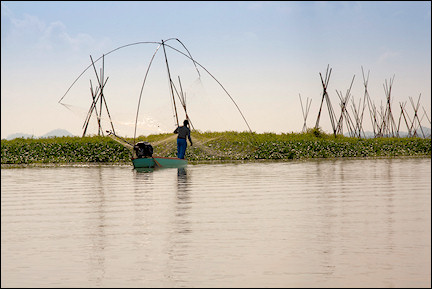
|
In Sengkang we hire a guide and a boat for a tour of Lake Tempe, a shallow lake with floating villages. Besides fishing, the fishermen also fixate fields of waterhyacints with bamboo stakes, to form nurseries for the fish. Bamboo screens of over a kilometer long prevent the fish from escaping their fate.
Along the river that connects the lake with the city, women are doing laundry. Apparently unfazed by the fact that 300 meters upstream sewage flows into the river.
Via Palopo to Rantepao
In the morning, physical exercise and the national anthem in the school yard
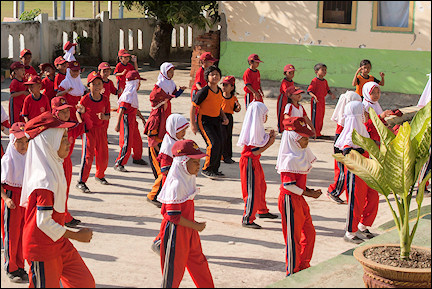
|
At six AM we lay a foundation for a day of biking with a meal of fried rice and coffee. When we ride our bikes in the city, the schoolyards are already buzzing with activities: physical exercise, followed by singing the national anthem.

|
Our attempt to stay unnoticed while taking pictures fails. The teachers signal us to come in. In no time at all we are exercising our muscles too, and everyone thinks that is hilarious. We can't leave before we have taken pictures of every teacher individually and one of the whole group.
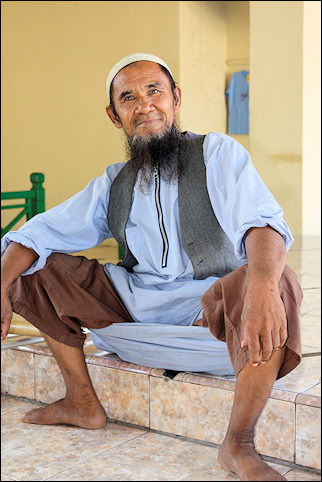
|
South Sulawesi is predominantly Islamic. There are so many mosques that the muezzins' calls to prayer regularly clash. We don't notice much of the Islamic character of the country, except at 4:30 AM. Less than half of the women in the street are veiled. And veil or no veil, physical contact is not avoided, as our photo sessions show.
In Palopo we visit the oldest mosque in South Sulawesi, the Masjid Jami Tua Palopo dating from 1604. Boys and girls are being taught the art of reciting Quran texts. Despite our bare legs and uncovered hair we are made to feel very welcome. Our idea that Indonesia is moving towards fundamentalism turns out to be a prejudice. At least here in South Sulawesi.
In contrast with other villages and towns we visit, Siwa is rather shabby. There are unusual amounts of garbage everywhere, even in around people's homes. When we take a stroll in Siwa in the evening, we are invited for a cup of coffee by a family with a daughter who speaks English rather well. It is a fun and educational visit.
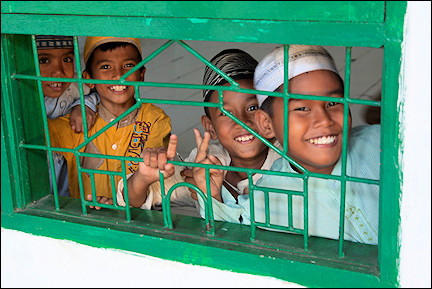
|
When we are back in our hotel room, an English teacher knocks on our door. Could we please help his students - most of whom are teachers - with English conversation.
Unfortunately the teacher loves to hear himself talk, so his students don't get much of a chance. In a city with only one hotel, two white people don't go unnoticed.
In between we enjoy our bike rides. We are in shape again, it's not as hot as before and the surroundings on our bike routes keep getting more beautiful.
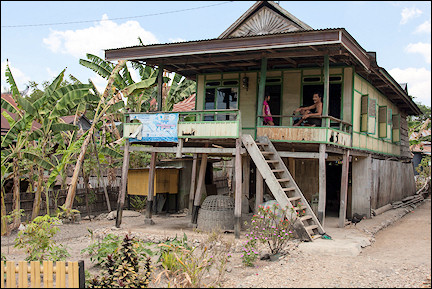
|
Underneath or around Buginese pile dwellings all kinds of activities take place: weaving silk; washing up at the well or under a makeshift shower (mandibak), all very modest; making the ugliest, oversized two-seater sofas you can imagine; and winning cocos from coconuts.
And of course repairing and washing the holy cows: Yamaha mopeds. Now also available with payment in instalments.
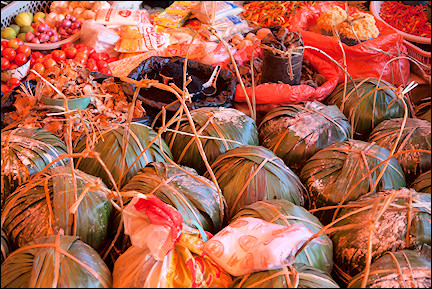
|
Cloves (flower buds of the clove tree) are being dried everywhere, spreading their scent. To pick the flower buds, bamboo sticks with cross sticks are used as ladders. Up to eight meters high. Very dangerous.
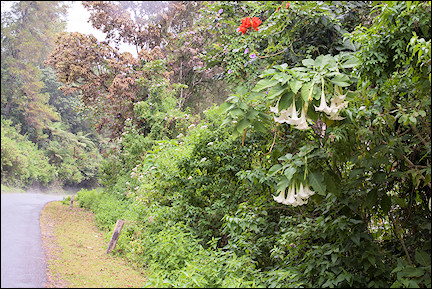
|
The highlight of our trip is the ride from Palapo to Rantepao, from sea level to 1,200 meters with some climbs and descents in between. It's a tough ride, but the beauty on the way is indescribable. Jungle, amazing views, daturas (Angels' trumpets) with hundreds of flowers that smell wonderful, and water everywhere.
Rantepao
Twenty pigs are slaughtered in two hours for the ceremony
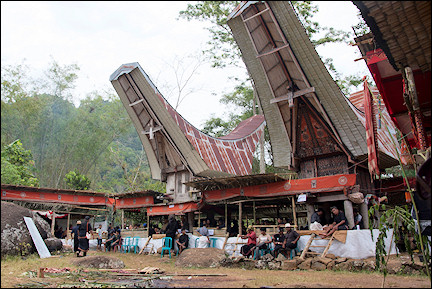
|
Rantepao is the touristic center of South Sulawesi, with lots of hotels and restaurants. And a few dozen white tourists: elderly couples with big bellies, sporty young blond divers and dreadlock types who walk around in traditional sarongs.
And of course two sporty sixty-somethings on their bikes. This for a personal touch.
A guide takes us to a burial ceremony, the trademark tradition in this area. The ceremony takes place by the house of the deceased. It is a traditional Toraja house with a roof that looks like an upside-down ship. Around the house are six rice storage sheds on poles, with the same typical roofs. Everything is lavishly decorated with wood carvings.
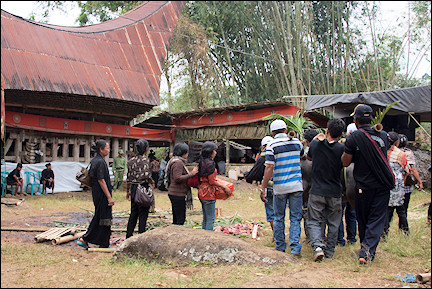
|
The object of the ceremony is an approximately 80 years old man who died three years ago. He was embalmed and placed in a beautiful wooden coffin in his family's house, until his family saved enough money for the expensive traitional burial. After the burial ceremony he will be placed in a rock grave, where he will guard the wellbeing of his family.
The ceremony takes a couple of days. On the day of our visit, family members, local government and church officials, neighbors, acquaintances and acquaintances of acquaintances pay their respect and offer gifts that are meant to provide the deceased with goods in the hereafter. Kind and size of the gifts are based on the status of the family.
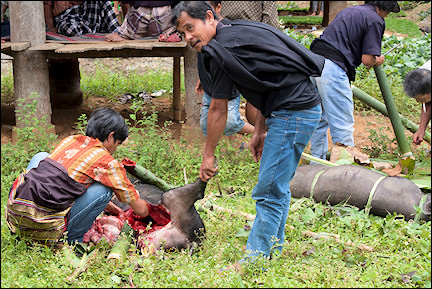
|
The most popular gift turns out to be a pig. Constrained between bamboo sticks they are shown to close family members. Immediately after this, they are killed with a knife in the heart and then their entrails are removed.
During the two hours of our visit, some twenty animals lose their lives, loudly protesting. We follow our guide's advice and offer a carton of cigarettes. Less messy.
Together with the other guests, an estimated 500-800 people, we are put on stages that were built for the occasion.
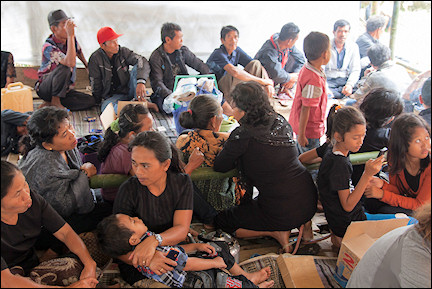
|
A group of traditionally dressed women provides us with food and drinks: palm wine, rice and a dish with vegetables and meat, with pork entrails cooked in bamboo sticks. The pieces of liver are edible. We make the tough pieces of intestine disappear through holes in the floor.
We miss the serious part, offering and killing buffaloes. This is planned for the day after tomorrow. The buffalo horns are attached to the house's main pillar. The more horns, the higher the family's status. Dozens of horns are no exception. The souls of the animals are supposed to accompany the soul of the deceased to the hereafter.
As strange as it may sound, we don't feel like voyeurs, even though we are tourists here. As with other occasions, we feel welcome.
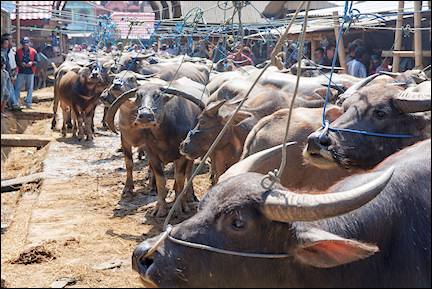
|
On Sunday we visit the weekly regional market. It's a colorful spectacle and, just like in our own country, everything you can think of is sold here. From Chinese hats for planting rice to Viagra pills. But also roosters for fights; their abilities are demonstrated on the spot.
At the pig and buffalo market there is much to be seen. Standard buffalo, but also (in order of price) multicolored and albino ones. The latter for a price you could buy several cars with. And we are not talking about a few buffalo, but hundreds. Most of them are for offering at mourning ceremonies like the one we attended yesterday. Humane societies could do a lot of good work here.
Touring Batutumambo
A quilt of paddies in different shades of green
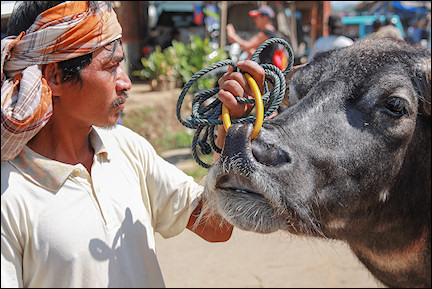
|
We are craving a bike ride. Our destination is Batutumambo. In the Lonely Planet it is praised for its wonderful views. Our route description advises to take the same route on the way back, and also not to go by bike, but to hire a guide with moped. But after two days of rest we need some exercise.
We pedal from almost 800 to over 1,500 meters height. There is so much to see on the way. Partly because the road is terrible, but also because of the landscape. A quilt of paddies in different shades of green, surrounded by little dams in all kinds of shapes. Tourist brochures for Bali eat your heart out. In between paddies there are villages, bamboo, coffee shrubs and woods.
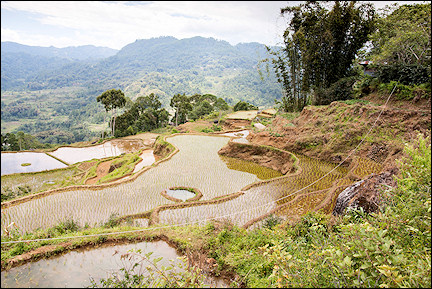
|
When we have reached the highest point of our trip, and our route description says 'turn back now', we decide to take a different route back. According to a guide we meet at a rock burial place says it's possible.
For lack of a decent map (the GPS shows a blank for this area), we depend on the locals, who consistently tell us to turn back when we mention Rantepao.
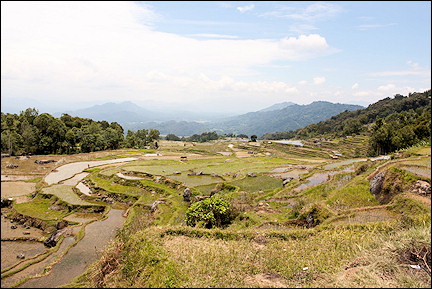
|
Stubborn as we are, we continue on towards the town of Kepe, which was mentioned by the guide. Upon arrival in Kepe it becomes clear why everyone on the way gave us a negative travel advice. The descent to Rantepao is not just very steep, but also not even fit for a mule.
With our kidneys in our pants pockets, cramped up hands on the brakes and sore behinds, we are back in Rantepao within an hour. A tribute to Dutch bicycle makers.
Through the South Sulawesi inland
Along Toraja villages in a fairy-tale Karst landscape
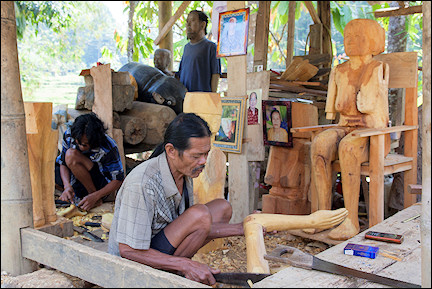
|
We return to Makassar via a hilly route through the South Sulawesi inland. About 400 kilometers in six legs. The first one is only 25 kilometers and ends in Makale. It takes us the better part of the day.
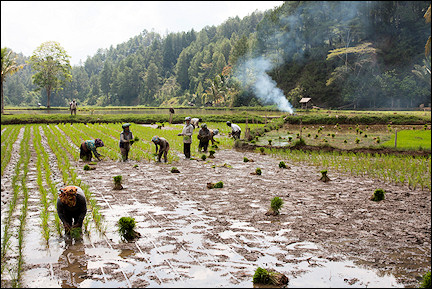
|
There is a lot to see on the way: old Toraja villages, a workshop where wooden statues are made, based on pictures of deceased loved ones, the construction of new Toraja houses and rice threshing. When Gerrie offers to help, this is enthusiastically accepted. But when we see people planting rice shoots, she doesn't offer to help.
It is a fairy-tale landscape. Narrow roads between paddies, surrounded by Karst mountains, butterflies in all kinds and sizes, buffaloes of which we only see the heads sticking out from the mud.
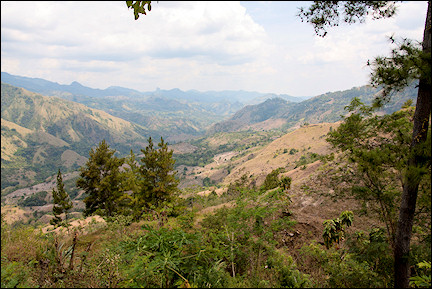
|
We end our second leg in a completely different landscape: bare and wild. Instead of paddies, there are fields of white and green cabbage. Without the mountains with their colorful slopes we'd think we were in Holland. We spend the night in an elegant villa with a wonderful view of the mountains.
Back to Makassar
"Hello mistèèr, where do come from, where do you go?"
During the next four legs the landscapes vary. Level parts where cows feast on rice stubble and hilly parts with cocoa shrubs, banana plants, rough woods and terraces with paddies.
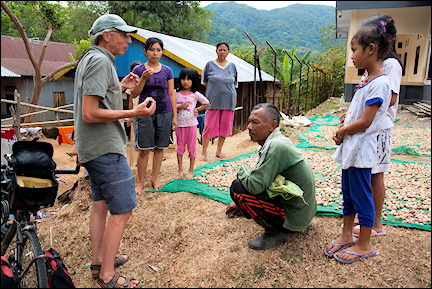
|
It's hard work. Many small hills make a big mountain. There are long stretches with a 7-10 percent incline. With 15 kilos of luggage, that is quite a shlep. But not as bad as the 18 percent incline we had earlier. Even on foot that one was hardly doable.
On top of that, moped riders and car drivers do their utmost to make the climb even harder. While we panting with our tongues out, people honk: "Hello Mister, where do come from, where do you go?" As if we have any breath left for small talk. But, apart from that, no complains about motorized traffic here.
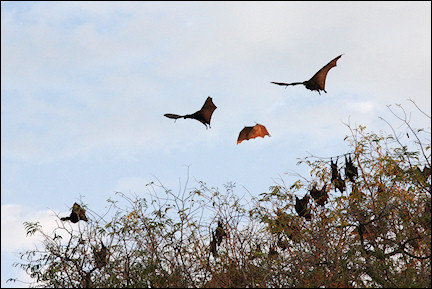
|
When we stop and consult the directions under a tree, it turns out the tree houses a colony of large bats (fruit bats or megabats). Hundreds of them are hanging from the branches of the trees and flying around. With their wingspread of 40-50 centimeters it is an impressive sight.
We take a look in a brick plant. As in other places we visited, people like it when we show interest in their work. The production process is standard: clay, mould, brick, dry, bake. Only the execution is somewhat primitive: it is all done by hand.
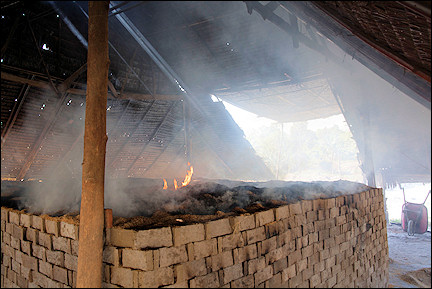
|
The baking is done by building an oven with stacks of bricks and fill them with rice chaff as fuel. This is covered with a roof of palm leaves. What we see: flames, smoke and sunbeams that draw lines in the smoke. It's a beautiful sight.
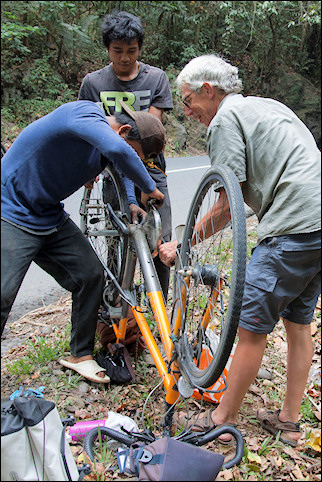
|
When we see something drying along the road that looks like nutmeg, we use the translation app on our smartphone to ask if that is right. It's not. A young woman types 'kemiri'. Her husband cracks some kemiri nuts with a rock so we can taste them. A neighbor woman gets some peeled ones from her house and also brings a baby with whom Gerrie must be photographed. It feels so natural. Communicating without knowing each others' languages.
The last leg takes us through the Natural Park Bantimurung. We see beautiful rock formations; we even bicycle under stalactites. But the route is also very hilly. When Gerrie shifts gears during a climb, the chain on her bike gets stuck. In hindsight, it was not correctly set.
We take off the luggage and turn the bike upside down to try and get the chain loose. Two handy kids join us and a little later there are eight black hands.
After some moments of despair and 60 minutes later, everything is all right. Apparently it's no big deal that the chain misses a few links now.
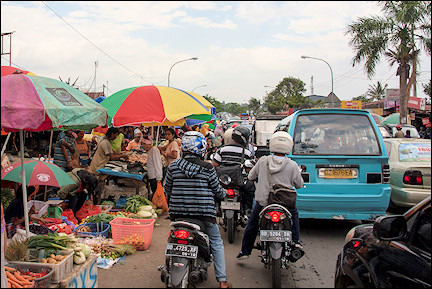
|
The last 30 kilometers to Makassar show the metropolitan character of the city. Crowded, busy and lots of noise. Incredible amounts of mopeds and two brave Dutch bikers weave between cars that are stuck in places where bridges were not included when the road was widened.
Or in places where one of three lanes is in use for a market and the second one for the cars of visitors of that market.
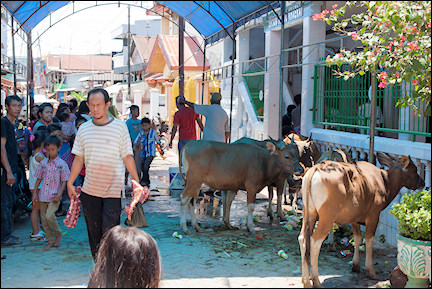
|
And then we are back where we started, three and a half weeks ago: Makassar and a luxury hotel with swimming pool, where swimming is done clothed from head to ankles. But where you also can get a beer.
When we explore Makassar a little more, it turns out that today is a Muslim holiday: Eidh al-Adha (Festival of the sacrifice). It commemorates the sacrifice by Ibrahim(Abraham) of his son, which was prevented by Allah just in time. The city center is quiet and deserted. That doesn't go for the residential areas around it.
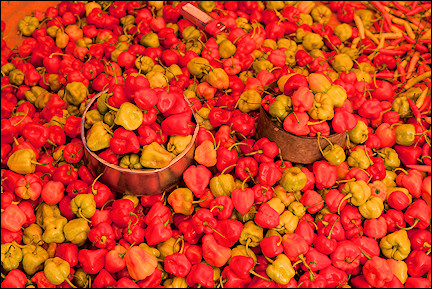
|
Many people are wearing their best clothes. Around mosques it is very crowded. Cows and goats are ritually slaughtered, there is a lot of blood. Everywhere, people ask us to take a look and take pictures.
But after the mourning ceremony in Toraja we've had enough of the public slaughtering of animals.
Fortunately Fort Rotterdam is open on this holiday. It is the place where the Dutch controlled the port of Makassar in the seventeenth century.
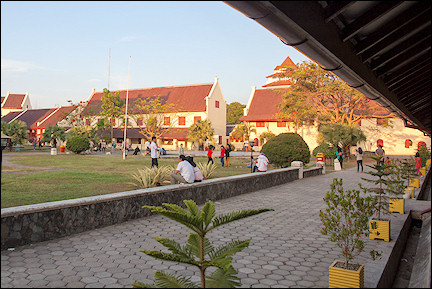
|
It is one of the few building on this island, apart from the memorials for the War of Independence, that remind us of the Dutch rule in Indonesia.
However, Dutch heritage lives on in the language, with words like direksie keet (site office) and poskantor (post office). Lots of words in Bahasa Indonesia can be reduced to their Dutch origin.
This concludes our trip. We enjoyed it.